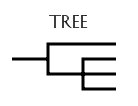
AVES
Coraciimorphae
Chapter Outline
- Description of Aves
- Classification of Aves
- Palaeognathae
- Neognathae
- Neoaves I
- Neoaves II
- NeoavesIII
- Neoaves IV
- Telluraves
- Coraciimorphae
- Australaves
- Passeriformes

NCBI Tree | Paleo Tree
Links to external sites will appear in pop-up windows.
A subgroup of Telluraves, Coraciimorphae contains 5 orders of land birds.
- Telluraves
| BUCEROTIFORMES - HORNBILLS | |
The order of Hornbills and Hoopoes. As of 2024, 0 species of Bucerotiformes have been observed in iNaturalist in the US and 65 throughout the world.
|
Resources: |
| COLIIFORMES - MOUSEBIRDS |
The order of Mousebirds. As of 2024, 0 species of Coliiformes have been observed in iNaturalist in the US and 6 throughout the world.
Mousebirds are native only to Sub-Saharan Africa. In the U.S., they can be experienced at two of the zoos in Trip 6 (Omaha and Sedgwick County), the San Diego Zoo and Safari Park in Trip 7 and the Smithsonian Zoo in Washington, D.C. in Trip 10. Trip 7 is where you can experience both species of mousebird in the same trip.
|
Resources: |
| CORACIIFORMES | |
In this order of Kingfishers, Rollers and Bee-Eaters, there are three species native to the U.S. proper and four more native to it's territories. The most commonly observed kingfisher is, by far, the Belted Kingfisher (Megaceryle alcyon). The Guam Kingfisher (Todiramphus cinnamominus), native to the U.S. territory Guam, is, unfortunately, extinct in the wild but can still be experienced at a couple zoos in Trip 6 that are trying to save the species.
Other than kingfishers, there are no other species from this order native to the U.S.
As of 2024, there have been 176 species of Coraciiformes observed in iNaturalist worldwide.
|
Resources: |
| PICIFORMES | |
The order of Woodpeckers, Toucans, Barbets and allies. As of 2024, 32 species of Piciformes have been observed in iNaturalist in the US and 385 throughout the world.
Of the 32 species from this order native to the U.S., all are woodpeckers in the family Picidae. Representatives from the families Lybiidae (Barbets) and Ramphastidae (Toucans) can be experienced at various zoos.
Resources:
|
| TROGONIFORMES - TROGONS | 9 |
The order of Trogons and Quetzals. As of 2024, 2 species of Trogoniformes have been observed in iNaturalist in the US and 46 throughout the world.
In the US, the most likely places to experience trogons are in a few "sky islands" in southern Arizona. The Chiricahua, Santa Rita and Huachuca Mountains are some of the best places to look. The two species of trogon found in the U.S. have been observed in these areas.
The Sedgwick County Zoo, in Trip 6, also has a representative from the order, the Golden-Headed Quetzal (Pharomachrus auriceps). The Baltimore Aquarium, in Trip 10, has had a species from the genus Trogon in the past and may still.
|
Resources: |
| [ Previous Page ] | [ Next Page ] |